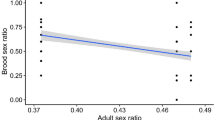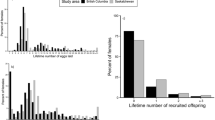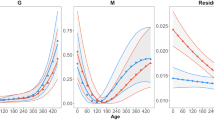Abstract
A GENERAL problem of parental investment is that resources required to nourish offspring may be unpredictable at the time fertilization occurs1–5. Lack1 suggested that the best strategy for altricial birds faced with such unpredictability might be to lay an optimistic clutch size and to begin incubation before laying is complete. This causes the eggs to hatch asynchronously, which may allow the brood to be reduced to the optimum size by the quick elimination of the youngest nestling if food is scarce. If females hatched their eggs synchronously, food shortage could lead to poor growth of the whole brood if the nestlings are then equally competitive. Lack predicted that synchronous and asynchronous broods would consequently be equally productive in times of plenty, but asynchronous broods would be better when food is scarce1,3. By manipulating both food availability and brood hierarchies, and following offspring survival after fledging, I show that in blackbirds (Turdus merula) asynchronous broods are more productive when food is scarce, but not when food is abundant.
This is a preview of subscription content, access via your institution
Access options
Subscribe to this journal
Receive 51 print issues and online access
$199.00 per year
only $3.90 per issue
Buy this article
- Purchase on Springer Link
- Instant access to full article PDF
Prices may be subject to local taxes which are calculated during checkout
Similar content being viewed by others
References
Lack, D. Ibis 89, 302–352 (1947).
Martin, T. E. A. Rev. Ecol. Syst. 18, 453–487 (1987).
Lack, D. Ecological Adaptations for Breeding in Birds (Methuen, London, 1968).
Stephenson, A. G. A. Rev. Ecol. Syst. 12, 253–279 (1981).
Perrigo, G. Anim. Behav. 35, 1298–1316 (1987).
Clark, A. B. & Wilson, D. S. Q. Rev. Biol. 56, 253–277 (1981).
Mock, D. W. in Infanticide: Comparative and Evolutionary Perspectives (eds Hausfater, G & Hrdy, S. B.) 3–30 (Aldine, New York, 1984).
Bryant, D. M. Ibis 120, 16–26 (1978).
Hahn, D. C. Anim. Behav. 29, 421–427 (1981).
Stinson, C. H. Evolution 33, 1219–1225 (1979).
Cash, K. J. & Evans, R. M. Behav. Ecol. Sociobiol. 18, 413–418 (1986).
Amundsen, T. & Stokland, J. N. J. anim. Ecol. 57, 329–344 (1988).
Perrins, C. M. J. anim. Ecol. 34, 601–647 (1965).
Gustafsson, L. & Sutherland, W. J. Nature 335, 813–815 (1988).
Pettifor, R. A., Perrins, C. M. & McCleery, R. H. Nature 336, 160–162 (1988).
Slagsvold, T. J. anim. Ecol. 55, 1115–1134 (1986).
Snow, D. W. Ibis 100, 1–30 (1958).
Edwards, C. A. & Lofty, J. R. Biology of Earthworms (Chapman & Hall, Lonson, 1972).
Meaden, F. A Manual of European Bird Keeping (Blandford, Poole, 1979).
Slagsvold, T. Ornis. Scand. 16, 81–87 (1985).
Skagen, S. K. Ecology 68, 1747–1759 (1987).
Skagen, S. K. Auk 105, 78–88 (1988).
Gibbons, D. W. J. anim. Ecol. 56, 403–414 (1987).
Bengtsson, H. & Rydén, O. Behav. Ecol. Sociobiol. 12, 243–251 (1983).
Greig-Smith, P. J. Zool. 205, 453–465 (1985).
Moreno, J. Ornis. Scand. 18, 302–309 (1987).
Ricklefs, R. E. Avian Biology Vol. VII (eds Farner, D. S., King, J. R. & Parkes, K. C.) 1–82 (Academic, New York, 1983).
Ross, G. J. S. Maximum Likelihood Program (Rothamsted Experimental Station, 1980).
Feinberg, S. E. The Analysis of Cross-classified Categorical Data (MIT, Cambridge, 1977).
Author information
Authors and Affiliations
Rights and permissions
About this article
Cite this article
Magrath, R. Hatching asynchrony and reproductive success in the blackbird. Nature 339, 536–538 (1989). https://doi.org/10.1038/339536a0
Received:
Accepted:
Issue Date:
DOI: https://doi.org/10.1038/339536a0
This article is cited by
-
Factors affecting fledglings survival in urban population of European blackbirds in Szczecin (NW Poland)
Scientific Reports (2023)
-
Hatching asynchrony as a parental reproductive strategy in birds: a review of causes and consequences
Journal of Ornithology (2023)
-
Ectoparasites exposure affects early growth and mouth colour in nestlings of a cavity-nesting raptor
Behavioral Ecology and Sociobiology (2021)
-
Hatching Asynchrony and Spring Climatic Conditions in the European Roller
Evolutionary Biology (2015)
-
Individual birds advance offspring hatching in response to increased temperature after the start of laying
Oecologia (2012)
Comments
By submitting a comment you agree to abide by our Terms and Community Guidelines. If you find something abusive or that does not comply with our terms or guidelines please flag it as inappropriate.



